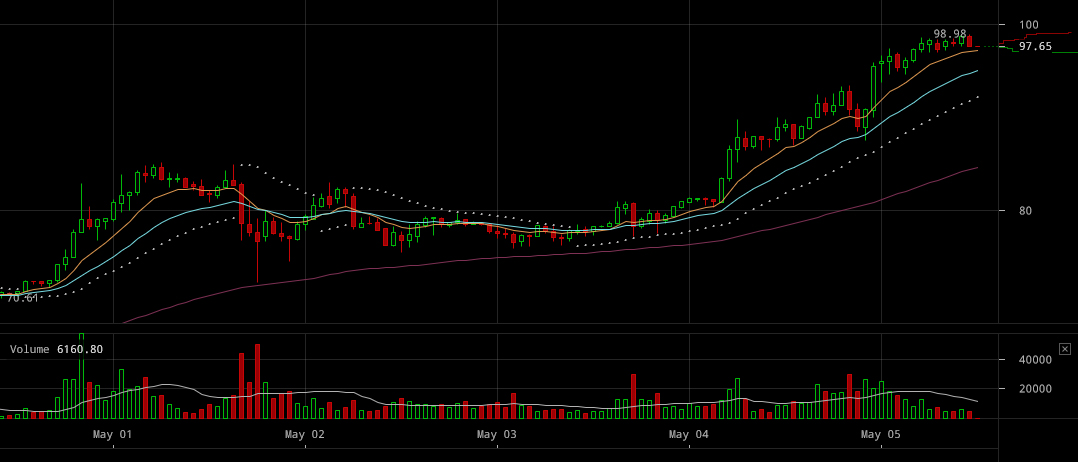Ethereum Rises Near Historic $100, Trades $10 Higher in South Korea

The ethereum spring is in full swing as the less than two years old digital currency rises from $5 in December 2016 to now trade at almost $100, with its market cap rising above $9 billion, up $1 billion since yesterday.
It has been rising by $10 every day in the past three days, up from $70 to now $100, creating a party atmosphere in its trading sub, as well as undoubtedly minting some new millionaires in the past two months.

The reasons for this astonishing rise are numerous. The currency enjoys a clear and very ambitious roadmap towards unlimited scalability, the grand prize in this space. It further has clear leadership and a very competent development team whose interests are tied to ethereum as the vast majority of their funds are held in eth.
Their community is united, increasing confidence they will be able to face challenges, especially during significant upgrades such as to Proof of Stake. They further appear to be diverse politically, leading them to espouse an inclusive philosophy of “political neutrality.”
That has made them attractive to household brands, including JP Morgan, Microsoft, Intel and so on, which have entered into an Ethereum Alliance to tap into eth’s smart contracts and refine them for production ready use.
Ready or Not, the Market Says Sink or Swim
Currently, the platform isn’t really ready for the mainstream. That’s because in this space this is the 90s, with huge desktop computers, very limited 1MB external floppy disk storage, slow dial-up which often disconnects and, yes, sometime the computer will randomly crash, so we have to turn it on and off again.
But, it does work. It can also probably handle its version of windows 95 paint, such as Chronicle’s blockchenized sneakers authentication or Innogy’s eth based charging stations. It’s also having its own sort of dotcom rush, with an ICO boom and, yes, with seemingly no one waiting to get a piece of its code, eths.
Impatience is being shown especially by the South Koreans. Eth trades $10 higher there. Their main exchange has twice the volume of Coinbase’s Gdax. It’s a symbolic fact as much as informative.
While bitcoin’s main center after US was and remains China, a developing economy relying on cheap labor for mass low value manufacturing, eth’s main center after US is South Korea, an advanced economy with a GDP of some $2 trillion, ahead in some aspects of robotics, artificial intelligence, autonomous machines and electronics.
That’s because bitcoin’s security is heavily reliant on mass hardware manufacturing called ASICs and cheap energy, with vast datacenters which burn, some say, as much electricity as some small countries.
Eth partly relies on that too for now, but because it is soon to move to proof of stake, which means you can secure the network with just a laptop and nothing else through depositing some eth, it has limited investment in eth hardware as they will all soon be made obsolete as far as eth is concerned.
The Advanced Country Falls in Love with the Advanced Tech
On the other hand, if we are to be objective, eth is the most advanced blockchain based platform. It can do everything bitcoin can and can do it far better because eth’s transactions confirm in 17 seconds with plans to reduce it to 2 seconds, basically instant, while bitcoin’s transaction take 10 minutes on average, but even without backlogs can take one hour on rare occasions due to the somewhat random block finding function.
On top, eth can do many things bitcoin, or really any other platform, can’t. That’s because ethereum allows you to code certain rules, package it into a smart contract, send it some eth and watch it all work by itself.
What is extremely interesting is that this smart contract doesn’t have a private key. It doesn’t require any manual input. It can therefore autonomously transfer eth as per the coded rules with the entire network verifying it has the eth because you sent it and verifying that it can move the eth not based on a private key, but based on the rules of the contract.
That means we can blockchenize things. We give a robot a smart contract for example, or we give a factory machine some eth based rules, combine it with data analytics and other computer science aspects, such as wireless tech or sensors, and an entirely new world opens.
It is no wonder, therefore, that the most advanced blockchain technology has made one of the most advanced countries in tech fall in love with it. Which may mean a significant transition might be underway in this space as eth has risen in just months to not far from 50% of bitcoin’s market cap.
Featured image from Shutterstock.